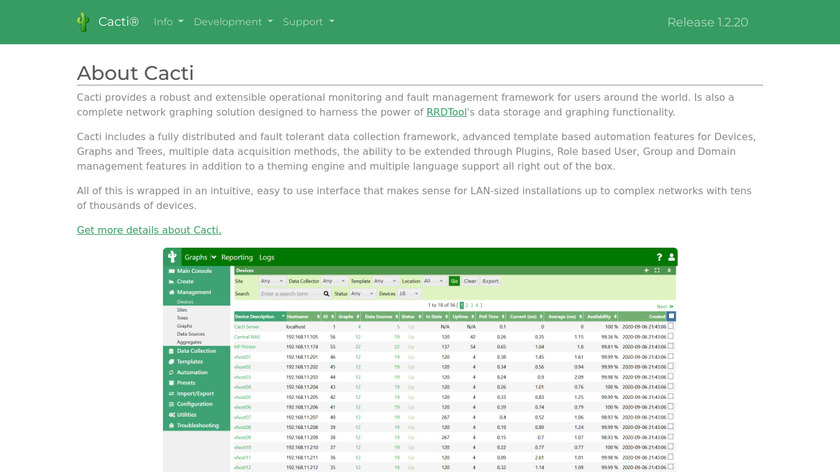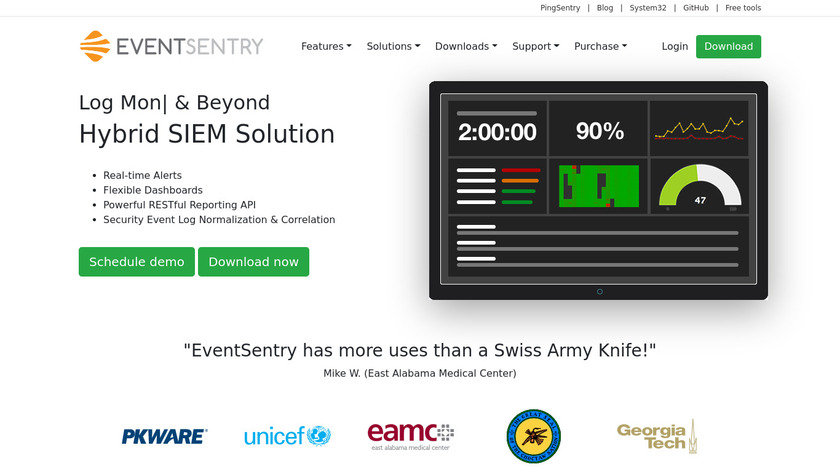-
Identify how bandwidth is being used with NetFlow Traffic Analyzer for SolarWinds Network Performance Monitor. Download free 30-day analyzer software trial!
Though this list accounts for both open-source and closed-source products, it focuses on Linux-based network monitoring tools. A handful of common tools only operate on Windows, Pandora, or other systems, but most network monitoring tools run on Linux systems since Linux—with its higher degree of user input and easily recodeable security bugs—is often the choice for IT specialists who wish to manage network systems in growing enterprises. For this reason, I’ve excluded the few non-Linux-compatible monitoring tools. My personal favorite is SolarWinds NetFlow Traffic Analyzer—read my review below to learn why.
#Monitoring Tools #Performance Monitoring #Log Management
-
An advanced network monitoring solution to monitor network up/downtime, traffic and usage.
Paessler is a German software engineering company with a narrow focus on monitoring and data management software. Its closed-source network monitoring tool, called PRTG Network Monitor, offers a lower emphasis on data visualization and graphics than SolarWinds NTA, but is still a highly scalable product, with customizable sensor options to meet the needs of variously sized companies.
#Monitoring Tools #Performance Monitoring #Log Management
-
Nagios Network Analyzer is a netflow analysis, monitoring, and bandwidth utilization software.
Nagios Network Analyzer can observe specified ports and devices for focused network monitoring. Like PRTG, the Nagios Network Analyzer contains data log monitoring software as well as network monitoring software, helping ensure your network and processes are running smoothly and without threat. If unusual activity is detected, Nagios Network Analyzer can send automatic alerts to the IT center regarding the type of aberration observed. And, like SolarWinds NetFlow Traffic Analyzer, it provides easy-to-use, color-coded graphics to visualize the data and information gathered from your server.
#Monitoring Tools #Performance Monitoring #Network & Admin
-
Zenoss is a patented, agentless, and hyper-scalable IT monitoring technology.Pricing:
Zenoss is another well-established name in the network monitoring business, and with good reason. The company has offered a variety of competitive monitoring products since it was founded over a decade ago. Zenoss is most famous for its open-source program, Zenoss Core, which provides a combination of network monitoring and data analytics programming. But Zenoss has more recently expanded to offer a more robust, closed-source package called Zenoss Cloud.
#Monitoring Tools #Performance Monitoring #Log Management
-
Icinga is a fork of Nagios and is backward compatible.Pricing:
- Open Source
Icinga 2 is a modified version of the well-respected Icinga, and it has recently gained popularity among IT specialists for its scalability and live monitoring tools. Icinga 2 is compatible with nearly any operating system, and it can measure a vast network and provide color-coded graphs. Although Icinga 2, like any open-source monitoring software, requires a bit more finesse to get started than a closed-source tool, it contains a highly interactive visual monitoring interface for easy access monitoring. It’s also quite innovative for an open-source program, as it uses open-source API technology. This enables Icinga 2 to monitor your network at high speeds, producing data visualizations capable of adjusting to input in real time.
#Monitoring Tools #Log Management #Performance Monitoring 8 social mentions
-
Project home page of OpenNMS - a java based network managememnt platform developed under the Open Source modelPricing:
OpenNMS has been around since the late 1990s, when it was established as a management-oriented open-source monitoring tool for businesses and large networks. It has since acquired a formidable online community with a streamlined process of modifications and improvements. OpenNMS prides itself on its notification system, which provides live updates to the central control based on API monitoring results. A unique aspect of OpenNMS is its focus on integration with industry-standard management tools, allowing for ticketing integration and southbound integration with other software programs. The alert system is comprehensive, with Java-native notifications as well as external notification scripts.
#Monitoring Tools #Performance Monitoring #Log Management
-
Cacti is a complete network graphing solution. It provides a fast poller, advanced graph templating, multiple data acquisition methods, and user management features.Pricing:
- Open Source
Cacti has been around for nearly 20 years, and it’s one of the most prominent names in open-source network monitoring software. Cacti allows multiple users to monitor network devices and log network data, and it offers privacy settings to determine which users have access to what items. It also visualizes data by using RRDTool, a data logging and graphing software. Cacti’s age and established reputation have led to a comprehensive online support system, with templates for how to operate the software on different devices.
#Monitoring Tools #Performance Monitoring #Log Management
-
Track, record, alert and visualize performance and availability of IT resourcesPricing:
- Open Source
- Free
Zabbix is a widely used and widely available network monitoring tool compatible with Linux and Unix systems as well as Windows and Solaris systems, which makes it a go-to for IT people of all sorts. Much like Cacti, Zabbix is an established monitoring tool with a significant online community. It provides a clean monitoring dashboard to detect changes in network activity, disk space, and CPU load to keep track of activity on your network. Zabbix can detect IT concerns or function lags due to its framework for SNMP, ICMP, and TCP monitoring. Moreover, it can use open-source alert software to notify the central control of any network malfunction.
#Monitoring Tools #Performance Monitoring #DevOps Tools 5 social mentions
-
Pandora FMS: Opensource monitoring softwarePricing:
Pandora FMS stands for Pandora Flexible Monitoring System, and it is indeed a flexible software. It provides a comprehensive network monitoring solution adaptable to practically any operating system and includes many options for application integration and sensor add-ons. The basic version performs a useful graphical analysis, which isn’t always a given in open-source network monitoring tools. In addition to machine monitoring, Pandora FMS includes features for multiple simultaneous application integration, as well as optional open-source tools to monitor heat and shutdown information, which is not commonly available in open-source software.
#Monitoring Tools #Performance Monitoring #Log Management 3 social mentions
-
A fully featured network monitoring system that provides a wealth of features and device support.Pricing:
- Open Source
LibreNMS shows its strength in its quick response program, which owes its efficiency to an open-source API software. This type of real-time monitoring isn’t uncommon for more modern iterations of Linux network monitoring tools, but it makes LibreNMS particularly useful in providing automatic updates on network performance to an expansive multimedia alert system. LibreNMS combines this useful API communication with a horizontally scalable network system, which lets users quickly expand the number of nodes monitored by the central control without too much hassle. Because it’s a relatively new program, founded in 2013, LibreNMS has many other useful twenty-first-century capabilities, like integration with Android and iOS apps, in addition to compatibility with virtual machines.
#Monitoring Tools #Network Monitoring #Performance Monitoring
-
An open-source systems monitoring and alerting toolkit.Pricing:
- Open Source
Prometheus is designed to be compatible with Linux and Unix systems. It provides an ample variety of basic network monitoring functions for free, including a comprehensive graphical visualization capacity due to its integration with the Grafana graphing program. Its built-in PromQL feature also provides customizable visualization of its interface. Prometheus is a newer software, so its community support mechanism may not be as robust as some others on this list, like Cacti and Zabbix. But it’s used by a surprising number of major company networks and will likely gain influence in the years to come.
#Monitoring Tools #Performance Monitoring #Log Management 218 social mentions
-
EventSentry is a real-time log management, network and server health monitoring solution.Pricing:
EventSentry Light is the last of the open-source tools on this list with the capacity to monitor networks—the remaining programs are all designed for small or personal servers, or for more focused monitoring purposes. Designed exclusively for small-business use, EventSentry Light is a barebones but effective tool for monitoring both network packets and data logs, with an alert system in place to warn of unusual activity in either of these input areas. There’s an online support community for EventSentry Light users, like with any open-source monitoring software, but more reliable user support is only available with the purchase of the more comprehensive closed-source version of EventSentry’s combined network/data monitoring software.
#Web Security #Cyber Security #Identity And Access Management
-
Observium
Observium Community is a Linux network monitoring tool designed for small servers. It provides a compendium of online experts who send its users biannual patches and updates to system software. It’s compatible with a wide variety of operating systems and uses standard SNMP network monitoring. Observium Community operates with an impressive variety of monitoring features, but it has small-scale aspirations—Observium Community admins warn that the program shouldn’t be used for large-scale networks, and it’s mostly operable on personal servers to manage network information flow.
#Monitoring Tools #Network & Admin #Performance Monitoring 2 social mentions
-
Monitorix is a system monitoring tool designed to monitor as many services and system resources as...
Monitorix is a small server monitoring device designed specifically for use in Linux, but it has since expanded to Unix-based operating systems. Although Monitorix operates on small servers exclusively, it provides a good deal of monitoring capabilities to update the user on system metrics. Its features have become increasingly comprehensive over the nearly 15 years since its inception, and it now can monitor everything from network capabilities to data consumption to disk drive heat, ensuring the user can observe most of the features critical to their network’s operating success. Monitorix also includes simple but effective color-coded graphs for visual trend analysis.
#Monitoring Tools #Performance Monitoring #Log Management
-
Scalable distributed monitoring systemPricing:
- Open Source
You’ll need to weigh scalability against other considerations. An open-source program like Ganglia is highly scalable—scalability is Ganglia’s niche—but it might not provide the easy visual interface or automatic data analysis some of the other tools can offer. A software like Ganglia, with low per-node overhead, may be useful for researchers looking to monitor the basics of large network operations. But for IT specialists monitoring a large company network, other programs might be a better fit. More comprehensive monitoring tools, like SolarWinds NTA or Nagios Network Analyzer, might be more desirable for their real-time graphical analysis and security alert systems.
#Monitoring Tools #Log Management #Incident Management
-
htop - an interactive process viewer for Unix. This is htop, an interactive process viewer for Unix systems. It is a text-mode application (for console or X terminals) and requires ncurses. Latest release: htop 2.
At this point in the list, we’re starting to review less-complex programs to monitor small-network use with accuracy and reliability. Htop (the H stands for the designer’s name, Hisham) doesn’t contain graphical analysis software, but it provides a flexible monitoring program that can be installed on Linux as well as Unix-based systems. Htop might not be the most visually pleasing monitoring software—its interface looks more like an old-school computer from an 80s movie—but it’s useful in providing live updates on network activity and storage capacity in plain English. Additionally, if you don’t want to parse through dozens of monitoring updates, htop’s interface uses an intuitive color-coding system.
#Command Line Tools #Monitoring Tools #Performance Monitoring
-
17BMW
BMW-NG
This product hasn't been added to SaaSHub yetIbmonitor is a terminal-based application, so it’s not as easily convertible to newer control units as some of the other monitoring tools. Nonetheless, if you’re using an older computer, ibmonitor is a tried-and-true tool for monitoring a wide variety of network activity with an interface you can personalize. If your goal is to monitor bandwidth usage and other basic Linux network updates for a small set of units, ibmonitor can provide simple analyses of your network and summarize your total network data, so you don’t have to crunch the numbers. Like htop, it uses color-coded text to make sense of the stream of data it provides, and you can find a wide range of online forums to explain features.
-
GUI network monitor for Linux.
EtherApe is a network monitoring software compatible with Linux/Unix systems that shows there’s strength in graphics. For IT specialists wishing to monitor small networks without the long lists of numbers and jargony script, EtherApe provides a slick graphical component for visualization of network data. Like some of the other open-source tools, it reads packets from your network and from a file, with support for commonly monitored devices like WLAN, FDDI, ISDN, and others. It’s modeled after a more antiquated monitoring software called etherman. EtherApe hasn’t been around for as long as some of the other programs on this list, so it’s possible its online community and webpage updates might not be as robust.
#Monitoring Tools #Log Management #Security 1 social mentions
-
19IBM
IBMonitor
This product hasn't been added to SaaSHub yetIbmonitor is a terminal-based application, so it’s not as easily convertible to newer control units as some of the other monitoring tools. Nonetheless, if you’re using an older computer, ibmonitor is a tried-and-true tool for monitoring a wide variety of network activity with an interface you can personalize. If your goal is to monitor bandwidth usage and other basic Linux network updates for a small set of units, ibmonitor can provide simple analyses of your network and summarize your total network data, so you don’t have to crunch the numbers. Like htop, it uses color-coded text to make sense of the stream of data it provides, and you can find a wide range of online forums to explain features.
Discuss: Best Linux Network Monitoring Tools for 2020
Related Posts
Comparison of Cron Monitoring Services (November 2023)
blog.healthchecks.io // 3 months ago
8 Best SpeedFan Alternatives for Computers for Windows and Mac
xtendedview.com // 5 months ago
7 Best Speedfan Alternatives for 2023
technize.com // 12 months ago
HWMonitor Review & Alternatives for 2023
comparitech.com // 5 months ago
Top 5 Cyber Security Online Courses to Make a Good Pay
analyticsinsight.net // 9 months ago
Hack the Box vs TryHackMe – A Comparative Analysis
nextdoorsec.com // 7 months ago

































